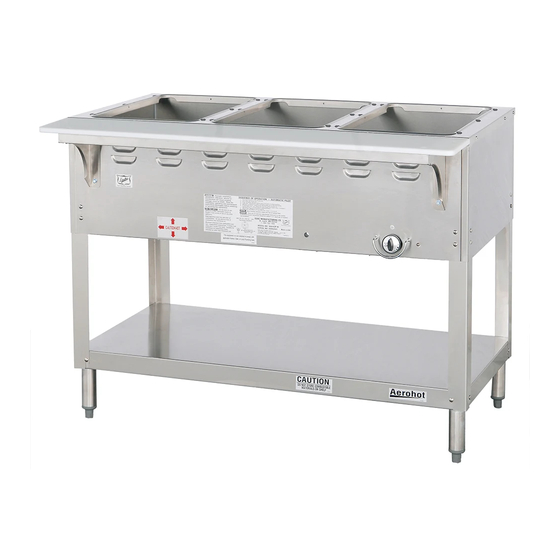Duke WB303-NAT Manuel d'entretien - Page 5
Parcourez en ligne ou téléchargez le pdf Manuel d'entretien pour {nom_de_la_catégorie} Duke WB303-NAT. Duke WB303-NAT 12 pages. Gas operated wetbath foodwarmers

MAINTENANCE
Stainless Steel Care and Cleaning
Stainless steel contains 70-80% iron, which will rust.
It also contains 12-30% chromium, which forms an
invisible passive film over the steel surface and acts
as a shield against corrosion. As long as the protective
film remains intact, the metal will not corrode.
However, if the film is broken or contaminated,
outside elements can begin to breakdown the steel
and begin to form rust or discoloration. To prevent
rust and discoloration on stainless steel, several
important steps need to be taken.
CAUTION: Never use steel wool pads or wire
brushes or scrapers.
Avoid cleaning solutions that
contain alkaline or chloride.
Use alkaline based or non-chloride cleaning
solutions. Anything containing chloride will damage
the protective film on stainless steel. Chlorides
are found in household and industrial cleaners
and also in hard water and salts. If a chloride or
alkaline cleaner has been used, rinse repeatedly
and dry thoroughly.
Always use only soft cloths or plastic scouring pads.
For routine cleaning, use warm soapy water. For
stubborn stains use a non-abrasive cleanser. For
heavy grease use a degreaser. For best results,
rub with the grain of the steel.
Pitting and cracking are early signs of stainless
steel breakdown. But special stainless steel
cleaners can restore and preserve the protective
film. If signs of breakdown appear, thoroughly clean
and dry all surfaces. Begin regular application of
a high quality stainless steel cleaner according to
the manufacturer's instructions. Again, always rub
with the grain of the steel for best results.
CAUTION: Never use an acid-based
cleanser! Be sure to clean
all food products from any
stainless surface. Many food
products contain acid, which can
deteriorate the finish. Common
foods include tomatoes, peppers
and other vegetables.
Gas Operated Foodwarmers
WARNING
THE GAS SUPPLY MUST BE TURNED
OFF AND DISCONNECTED AT ALL
TIMES DURING MAINTENANCE OR
REPAIR FUNCTIONS.
Gas Regulators
Figure 2.
Typical Gas Regulator
A regulator (see Figure 2) is a device for maintaining
a constant safe, operating pressure between a gas
source and a gas appliance. A regulator works
independently of supply pressure and flow.
Installation, service and repair of gas regulators
must be performed by qualified, certified
maintenance personnel.
The Vent Limiting Device is standard on the
regulators. The vent limiter limits gas levels to
within the ANSI safe standard level in the event
of a gas leak. It is absolutely necessary to provide
and maintain free airflow around the vent limiter.
5
